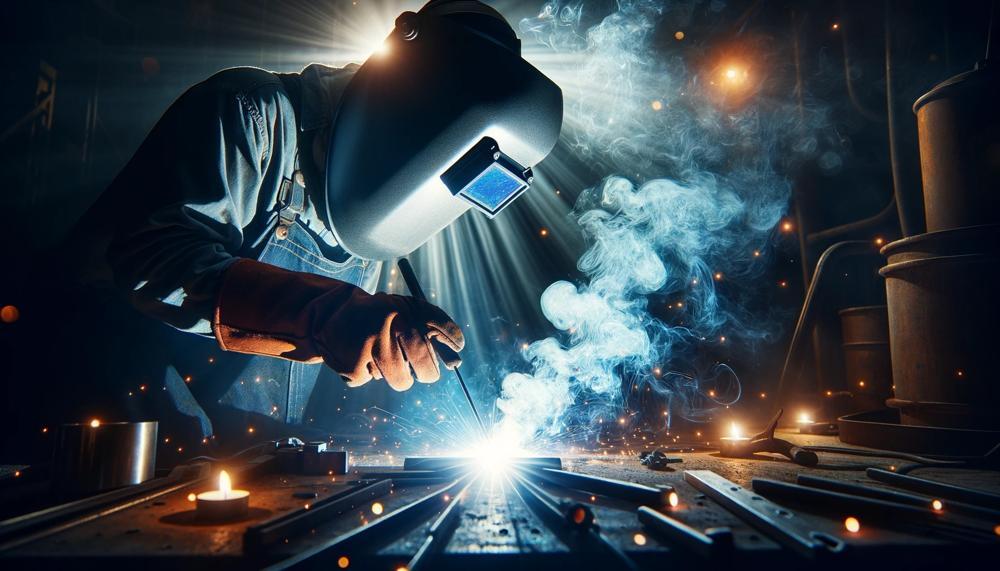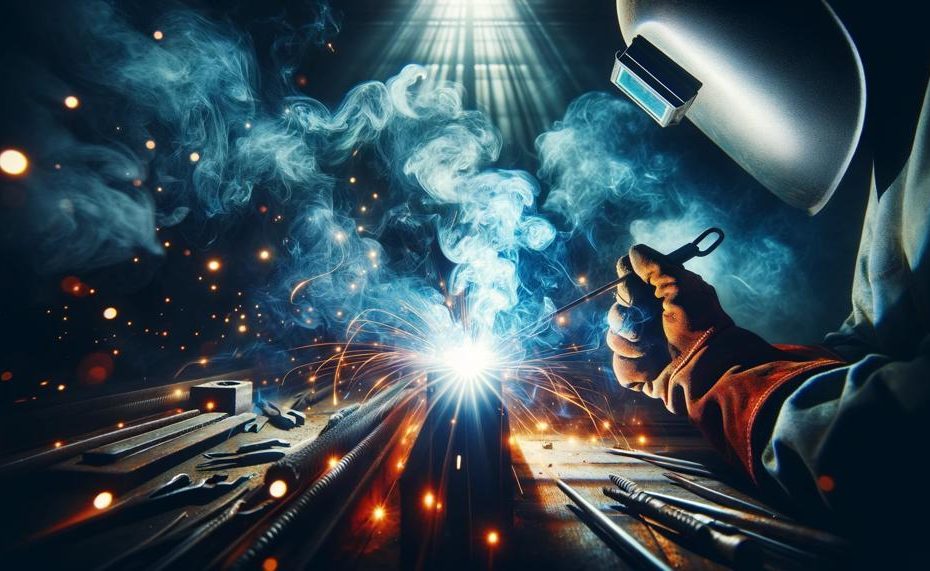Ever marvel at the brilliant light show a welder orchestrates, hidden behind their mask? That mesmerizing glow is not just a spectacle; it’s a welding arc, a cornerstone of modern fabrication and repair.
But have you ever stopped to wonder just how bright that light is? We’re not talking about your average flashlight or even a high-beam headlight here.
The luminosity of a welding arc is in a league of its own, and understanding it sheds light on both its incredible power and the stringent safety measures required to harness it.
So, how bright is a welding arc in lumens?
A welding arc can produce between 10,000 and 100,000 lumens per square, or NITs (newtons per square meter). A rough calculation for a 4 kW welding arc is 500 * 683 lm. Some say that a welding arc is double or triple the intensity of a bike light rated at 2500 lumens.
The brightness of a welding arc depends on the welder, the heat setting, and the amount of energy put into the arc. Welding arcs give off radiation over a broad range of wavelengths, including ultraviolet (UV) radiation (200 to 400 nm), visible light (400 to 700 nm), and infrared (IR) radiation (700 to 1,400 nm).
Welding operations involving metals should be supported by 300 lux of maintained average illuminance. For precision manual arc welding, 5,000-7,500 lux lighting levels may be supplemented.
Join us as we illuminate the fascinating world of welding arcs, a blend of raw power and precision engineering.
Contents
- 1 How Bright is a Welding Arc?
- 2 How Bright is a Welding Arc in Lumens?
- 3 How Hot is a Welding Arc in Celsius?
- 4 How can you Determine how Bright Welding Arc is?
- 5 Can Arc Welding Blind You?
- 6 How Hot is Mig Welding?
- 7 How Hot is Tig Welding?
- 8 How Hot is Stick Welding?
- 9 What is the Brightest Type of Welding?
- 10 Is Welding Hotter than the Sun?
- 11 Safety Precautions to Avoid from Welding Arc
- 12 Conclusion
How Bright is a Welding Arc?
The brilliance of a welding arc is a sight to behold, casting a glow that’s nothing short of spectacular. It’s like staring into the very heart of a star, except this star is right here on Earth, in the hands of skilled artisans shaping metal.
But let’s dive straight into the meat of the matter: the typical brightness level of a welding arc, when we talk numbers, and I mean lumens.
| Welding Process | Typical Brightness (Lumens) | Notes |
| MIG Welding | Up to 300,000 | Known for its high lumen output, aiding in clear visibility. |
| TIG Welding | Up to 200,000 | Produces a slightly lower, yet significant, lumen count. |
| Stick Welding | Varies | Depends on electrode and settings, but still intensely bright. |
| Flux Cored | Varies | Brightness depends on specific process parameters. |
In general, welding arcs light up the job at hand with anything from 10,000 to over 100,000 lumens. To put that in perspective, it’s like having a battalion of high-beam headlights concentrated in the palm of your hand.
This range isn’t just a number; it’s a testament to the power and precision that welders wield. High lumen output doesn’t just illuminate; it empowers welders to work with precision, making every join count.
Yet, it’s not just about making things bright for the sake of it. The right amount of light, the right kind of glare reduction—thanks to electrophoretic coatings on electrodes—makes all the difference. It’s about seeing clearly, working effectively, and most importantly, working safely. Because when you’re harnessing the power of the sun, safety isn’t just a suggestion; it’s an imperative.
Remember, the brightness of a welding arc isn’t just a number. It’s a beacon of craftsmanship, a testament to the skill and care that goes into every weld.
How Bright is a Welding Arc in Lumens?
Certainly. When we talk about lumens, we’re delving into the heart of what makes a light source bright to our eyes. Lumens measure the total amount of visible light emitted by a source, which means the higher the lumen count, the brighter the light. This concept becomes particularly interesting when we apply it to welding arcs.
Understanding Lumens in Welding Arcs
A welding arc is a source of intense light and heat, essential for fusing materials together with precision and strength. But just how bright is this source? The brightness of a welding arc can soar from 10,000 to an astonishing 100,000 lumens. That’s a staggering amount, especially when you compare it to the humble 800 lumens of a traditional 60W incandescent bulb or the 10W LED that shines just as bright.
he Significance of Lumens in Welding
The sheer brightness of welding arcs isn’t just for show. It’s a testament to the power and intensity needed to meld materials into a single, unyielding form. For welders, understanding the brightness in lumens isn’t just academic; it’s a vital part of ensuring safety and effectiveness in their craft.
| Light Source | Lumens (Approx.) | Usage |
| Traditional 60W Bulb | 800 | Domestic Lighting |
| 10W LED | 800 | Energy-Efficient Lighting |
| Welding Arc | 10,000 to 100,000 | Industrial Welding |
This intense light output underscores the importance of proper protective gear for welders, including helmets with specially designed filters to shield their eyes from harmful rays and the blinding brightness.
Adjusting Brightness for Welding Tasks
Given the variability in brightness, selecting the right settings and equipment for specific welding tasks is crucial. The choice of welding method, electrode size, and current settings can all influence the arc’s brightness, affecting both the weld’s quality and the welder’s safety.
Why Lumens Matter

In the realm of welding, lumens do more than just tell us how bright something is. They help define the conditions under which welders operate, ensuring that every spark contributes to a masterpiece of durability and strength. Welding arcs, with their high lumen output, aren’t just bright; they’re beacons of industrial artistry, illuminating the path to innovation and safety in the trade.
Understanding lumens in the context of welding arcs offers a clear window into the technical demands and safety considerations of this challenging profession.
How Hot is a Welding Arc in Celsius?
Welding arcs stand as a testament to the power of controlled electricity, creating heat intense enough to melt and fuse metals. Specifically, stick welding, or arc welding, dazzles with temperatures around 6,500 degrees Celsius.
This heat dwarfs many common and industrial heat sources, showcasing the unique capability of welding technology to manipulate and join metals with precision.
Comparison with Other Heat Sources
To place the sheer intensity of a welding arc’s temperature into perspective, let’s compare it to various other sources of heat, measured in Celsius:
| Heat Source | Temperature (°C) | Comparison |
| Wood Fire | 600 – 1,200 | Significantly cooler |
| Molten Lava | 700 – 1,200 | Significantly cooler |
| Household Oven (Broil Setting) | 260 – 290 | Vastly cooler |
| Sun’s Surface | 5,500 | Comparable, yet slightly cooler |
| Welding Arc | 6,500 | — |
This comparison paints a vivid picture of the welding arc’s temperature, placing it on a pedestal of intensity, surpassed only by phenomena such as the sun’s core or the heart of a nuclear explosion, neither of which are accessible or controllable in the way a welding arc is for industrial and crafting purposes.
Welding arcs, thus, are not just tools for joining metals but marvels of engineering that harness one of the most intense manageable heat sources on Earth.
How can you Determine how Bright Welding Arc is?
To fathom the brightness of a welding arc, one must engage with both the art and science of measurement. Welding arcs, akin to miniature suns on Earth, radiate intensely, their brilliance challenging yet captivating. Here’s how one might approach their luminescence:
Understanding Welding Arc Brightness
Radiated Heat and Intensity: At its core, an arc’s brightness can be gauged through its radiated heat and the intensity of light it emits, measured in candela. These measures, though indicative, orbit around the actual luminosity expressed in lumens.
Lumens Measurement: The true measure of an arc’s brightness, lumens encapsulate the total visible light emitted. For a welding arc, particularly one emitting green light at the peak visibility wavelength of 555nm, with a robust power output of 4 kW, lumens offer a direct insight into its visual force.
Measuring Techniques and Their Precision
| Method | Description | Precision |
|---|---|---|
| Radiated Heat | Estimates based on the arc’s temperature and heat output, using Stefan-Boltzmann law. | Indirect; lower precision |
| Candela Measurement | Direct measurement of light intensity using photometers, calibrated to human vision’s sensitivity. | Moderate; depends on calibration |
| Lumens Direct | Utilizing integrating spheres or goniophotometers to capture total visible light output. | Higher; subject to instrument accuracy |
Real-World Context
Considering a 4 kW welding arc:
- Its luminosity might span from 68,300 to 170,750 lumens.
- This equates to the brightness of about 100 traditional 100W incandescent bulbs or 11W LED lamps.
- Yet, variables like power output, spectrum, and surrounding conditions tweak these figures.
Accuracies and Variances
Each method has its own lens of accuracy. Radiated heat calculations might veer due to assumptions on emissivity and ambient conditions.
Candela measurements, though more direct, hinge on the precision of photometers and their calibration.
Lumens, arguably the most telling, still wrestle with methodological variances and equipment precision.
Can Arc Welding Blind You?
Yes, arc welding can potentially blind you. The intense light emitted from welding arcs, particularly the ultraviolet and infrared radiation, can cause a condition known as ‘welder’s flash’ or photokeratitis. It’s a bit like a sunburn, but on your corneas, leading to temporary or, in severe cases, permanent vision damage if proper precautions are not taken.
Understanding the Impact of Lumens in Welding Arcs
Lumens quantify the total amount of visible light emitted by a source, and the welding arc is a powerhouse in this regard. Its luminosity can be staggeringly high, which is essential for the welder’s visibility but perilous for the eyes without adequate protection.
- High Lumen Output: The brilliance of an arc can exceed 100,000 lumens, dwarfing the sun’s intensity. This intense light is crucial for the welding process, providing the illumination needed to achieve precise, high-quality welds.
- Risk of Photokeratitis: Without suitable eye protection, the intense UV and infrared radiation can burn the cornea, leading to photokeratitis. It’s painful and can result in temporary blindness, urging the necessity for protective gear.
- Balancing Brightness and Safety: While the high lumens improve work quality, they heighten the risk of eye injury. It’s a tightrope walk between leveraging the light for visibility and shielding the eyes from its harmful effects.
Table of Luminosity in Welding Processes
| Welding Process | Luminosity (Lumens) | Risk Level |
| MIG Welding | Up to 300,000 | High |
| TIG Welding | 10,000 to 200,000 | Moderate to High |
| Standard Arc Welding | 10,000 to 100,000 | Moderate |
How Hot is Mig Welding?
MIG welding, a staple in the metal fabrication world, hits temperatures up to a staggering 6,000 degrees Fahrenheit (about 3,315 degrees Celsius). That’s hotter than the surface of the sun, folks. This kind of heat is key for melting and fusing metals together, ensuring the welds are as tough as old boots.
Here’s a quick glance at how MIG stacks up against other welding hotshots:
| Welding Process | Temperature Range (°F) | Temperature Range (°C) |
| MIG Welding | 5,000 to 6,000 | 2,760 to 3,315 |
| TIG Welding | 10,000 to 15,000 | 5,537 to 8,316 |
| Plasma Welding | 20,000 to 50,000 | 11,000 to 28,000 |
As you can see, MIG’s hot, but it’s actually on the cooler side when you stack it up against the likes of TIG and plasma welding. Controlling this heat is a bit of an art form. Welders tweak the voltage and amperage and adjust the wire feed speed to keep the heat just right. And it’s not just about turning dials; how you handle the welding gun and the type of metal under your hands play a big part, too.
Welders have to be as sharp as a tack, wearing the right gear and keeping a beady eye on the weld. If it looks like there’s too much spatter, that’s a sign things are too hot. Time to adjust those settings.
How Hot is Tig Welding?
TIG welding, known for its precision and cleanliness, typically operates at scorching temperatures ranging from 3300°C to 20,000°C (6,000°F to 36,000°F). This vast range is influenced by several factors including the amperage used, the thickness of the material, and the type of metal being welded.
Achieving high-quality welds with TIG welding demands mastering the art of heat management, using techniques like pulse welding and carefully controlling the speed of the torch movement.
Selecting the correct tungsten electrode size and type is also critical for optimal heat control.
When diving into the world of TIG welding, it’s crucial to gear up with protective attire, ensure the workspace is well-ventilated, and stay hydrated due to the extreme heat involved.
| Temperature Range | 3300°C to 20,000°C (6,000°F to 36,000°F) | |
| Key Influencers | Amperage, Material Thickness, Metal Type | |
| Heat Management Techniques | Pulse Welding, Preheating, Torch Speed Control | |
| Tungsten Electrode | Size and Type Selection | |
| Safety Precautions | Protective Gear, Ventilation, Hydration |
TIG welding’s capability to reach such high temperatures, significantly hotter than those seen in MIG welding, highlights its suitability for a wide array of metals and applications.
How Hot is Stick Welding?
Stick welding, or shielded metal arc welding (SMAW), is a robust method that joins metals through the heat generated by an electric arc between a consumable electrode and the base metal. This arc blazes at temperatures between 5,000 to 6,500 degrees Fahrenheit.
The heat intensity can vary based on factors like electrode type, and the voltage and amperage settings, with the thickness of the metal also playing a pivotal role.
Compared to other welding techniques, stick welding arcs are notably hotter due to the consumable electrode that melts and burns, creating an intensely heated arc.
Let’s break this down in comparison to other welding types, focusing on how stick welding’s heat fares against them:
| Welding Type | Temperature Range (°F) | Characteristics |
| Stick Welding (SMAW) | 5,000-6,500 | Consumable electrode, high heat, suitable for various thicknesses. |
| TIG Welding | 6,000-36,000 | Non-consumable electrode, precise, clean, suitable for thin materials. |
| GMAW/MIG Welding | Similar to SMAW | Continuous wire feed, versatile, easier to learn. |
While stick welding’s arc is scorching, it is essential to note that it is considered a relatively low-heat process in comparison. This might seem counterintuitive, but the heat is focused in a small zone, allowing for welding of thinner materials without excessive warping.
The arc’s temperature can be influenced by the electrode type; for instance, low-hydrogen electrodes produce a hotter arc, demanding a welder’s adeptness in adjusting their machine’s settings to harness the desired heat efficiently.
Despite stick welding being one of the hottest types of welding, its slower travel speed affords welders enhanced control and precision, making it a commendable choice for a variety of projects.
What is the Brightest Type of Welding?
The brightest type of welding, when judged by the sheer luminosity of the arc, is Metal Inert Gas (MIG) welding.
MIG welding, known for its versatility and speed, also packs a punch in terms of brightness due to its high power output and continuous wire feed, which creates a consistently intense arc.
Comparative Brightness of Different Welding Types
| Welding Type | Brightness (Approx. Lumens) | Notable Features |
| MIG Welding | Up to 300,000 | Continuous wire feed, high power output |
| Stick Welding (SMAW) | 68,300 – 170,750 | Consumable electrode, intense heat |
| TIG Welding | Varies, generally lower than MIG | Non-consumable tungsten electrode, precise control |
MIG welding outshines its counterparts not only in luminosity but also in its ability to maintain a consistent and powerful arc, making it appear brighter to the observer. This intensity, however, requires stringent safety measures, as the brilliant arc can be hazardous to both the eyes and skin without proper protection.
In comparison, other types like Stick (SMAW) and TIG welding, though powerful in their own right, do not produce the same level of brightness. Stick welding, with its consumable electrode, offers a formidable arc but tends to be less bright due to the nature of its operation, which involves a slower travel speed and often thicker, less conductive materials.
TIG welding, famed for its precision and control, utilizes a non-consumable tungsten electrode that allows for very fine work at lower power levels, thus reducing its overall brightness in comparison to MIG welding.
Safety is paramount across all welding types due to the intense light and UV radiation emitted. Proper eye protection, such as welding helmets with appropriate shade levels, is essential to prevent “arc eye,” a painful condition caused by exposure to the UV light from the welding arc.
Is Welding Hotter than the Sun?
While it might seem like a tale spun from the fabric of the extraordinary, welding does indeed reach temperatures that appear to soar beyond comprehension, yet it does not surpass the sun’s blistering heat. Welding arcs blaze with intensity, reaching up to 10,000 kelvins (approximately 17,500 degrees Celsius or 31,500 degrees Fahrenheit).
This is staggeringly hot, hotter than the surface of the Earth can naturally achieve, making it a marvel of human capability to harness such power.
Despite these scorching temperatures, the sun’s furnace heart burns brighter and more ferociously. The core of our celestial anchor blisters at temperatures around 15 million kelvins (about 27 million degrees Fahrenheit).
Even the sun’s surface, a cooler exterior compared to its core, simmers at about 5,500 degrees Celsius (9,932 degrees Fahrenheit), still significantly outclassing the peak temperatures achieved in welding.
| Aspect | Welding Arcs | Sun’s Core |
| Temperature | Up to 10,000 Kelvins | Approx. 15 Million Kelvins |
| Human Interaction | Direct, with protection | None, too far andamp; too hot |
| UV Radiation | Emits harmful UV rays | Intense, mostly blocked by atmosphere |
The necessity for welders to don protective gear — helmets, gloves, and suits — speaks volumes about the intense brightness and heat generated by welding arcs. These safety measures guard against the ultraviolet radiation that can, without shield, harm skin and eyes with grave immediacy.
Yet, it’s the sun, with its colossal power and light, that still commands the sky. Our planet’s life-giver, its warmth reaches us, filtered through the atmosphere, a natural shield against the most harmful of its emissions. Pollution threatens this protective barrier, highlighting the importance of caring for our environment to maintain the delicate balance that allows life to flourish.
Welding’s might, while formidable, remains a flicker in comparison to the sun’s overwhelming inferno.
Safety Precautions to Avoid from Welding Arc
The craft of welding, while indispensable in creating and repairing metal structures, brings with it several hazards that demand respect and caution.
With a focus on arc welding, we delve into the potential dangers and the protective measures that shield welders from harm.
| Hazard | Prevention | Protective Gear |
| Electric Shock | Insulate body and work area | Dry, insulating gloves |
| Fire Hazards | Wear fire-resistant clothing, keep extinguishers handy | Fire-resistant clothing, fire extinguisher |
| Fumes and Gases | Ensure adequate ventilation, use respiratory protection when necessary | Exhaust systems, appropriate masks |
| Noise Hazards | Use ear protection to reduce risk of hearing loss | Earmuffs or earplugs |
| UV/IR Radiation | Utilize welding helmets with proper filter shade, cover skin | Welding helmet, long-sleeved clothing |
Each of these precautions is a bulwark against the risks posed by welding, embodying the adage that an ounce of prevention is worth a pound of cure.
Engaging in welding with these safeguards not only ensures personal safety but also upholds the quality and integrity of the work.
Conclusion
Welding arcs, with their dazzling lumens, highlight the remarkable fusion of technology and skill in the world of metal fabrication.
These arcs, producing light from 10,000 to an astonishing 300,000 lumens, outshine the brightest headlights, illuminating the path for welders to work with precision and care. This brilliance, while a tool for clarity and precision in welding, underscores the indispensable need for protective gear.
The intense luminosity not only demands respect for its power but also calls for rigorous safety protocols to shield the eyes and skin from potential harm. The comparison with the sun’s brightness brings into perspective the controlled yet formidable power welders harness on Earth, a feat that blends raw energy with the finesse of craftsmanship.
As we marvel at the sheer intensity of welding arcs, it’s the careful balance between leveraging this light and protecting oneself that exemplifies the art and science of welding.





